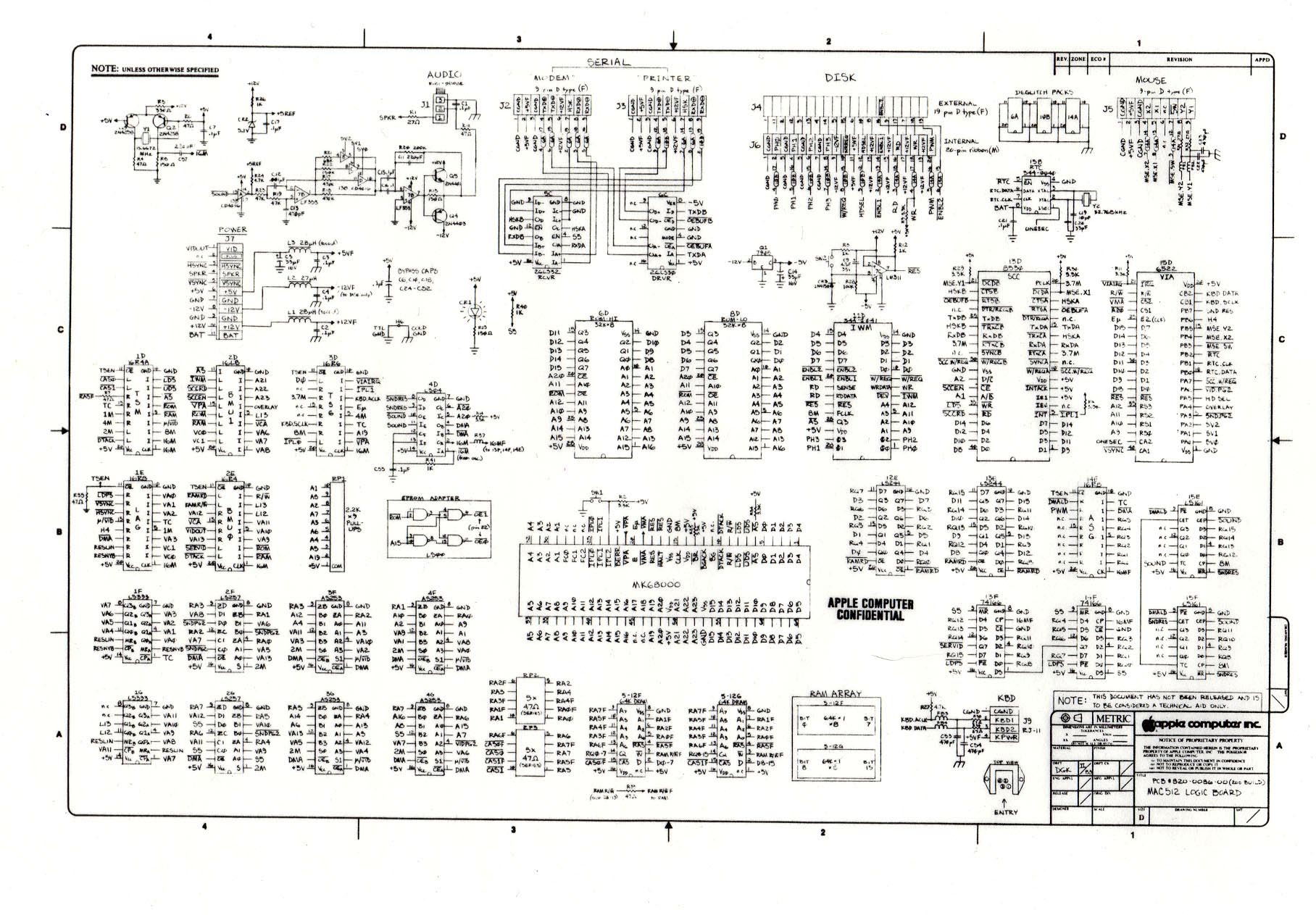
Original Macintosh 512K Logic Board Schematic

The following is one of the rare and significant documents at DigiBarn, the only known copy of the complete schematic specification for the 512K Macintosh Logic Board. Co-authored by Daniel Kottke, this design served as the foundation for the 64K Macintosh prototypes and the launch of the 128K Macintosh in January 1984. This may be the last major computing system entirely designed on a single sheet of paper, detailing all connections and specifications for the chips. The original D-sized diagram has not been located, but Daniel provided a smaller facsimile from the same period. Legend has it that Steve Jobs requested a 128K logic board design; however, the engineers designed it to accommodate 512K to facilitate memory upgrades, anticipating that early adopters of the Macintosh would quickly seek to enhance their systems. Additional images of Daniel Kottke's early Apple Macintosh circuit boards can be found here.
The 512K Macintosh Logic Board schematic is a pivotal document in computing history, representing a significant advancement in personal computer design during the early 1980s. This schematic encapsulates the architecture of the Macintosh system, showcasing the integration of various components, including the CPU, RAM, ROM, and peripheral interfaces. The design emphasizes modularity and upgradeability, allowing users to expand their systems beyond the initial memory specifications.
The logic board features a Motorola 68000 microprocessor, which was central to the Macintosh's performance capabilities. The schematic details the connections between the CPU and other essential components, such as the memory banks, which are configured to support up to 512K of RAM. The layout illustrates the bus architecture, which facilitates communication between the CPU and memory, as well as the input/output interfaces for peripheral devices.
The design also includes a ROM chip that stores the Macintosh operating system, enabling the system to boot up and run applications. The schematic specifies the pin configurations and electrical characteristics necessary for proper functionality, ensuring that each component operates within its designated parameters.
Furthermore, the foresight of the engineers is evident in the design's emphasis on upgradability. By accommodating additional RAM, the logic board allowed users to enhance their computing experience, reflecting the evolving needs of early Macintosh users. This strategic decision not only improved the longevity of the Macintosh but also contributed to its reputation as a user-friendly and adaptable computing platform.
Overall, the 512K Macintosh Logic Board schematic is not merely a technical document; it represents a milestone in the evolution of personal computing, encapsulating the innovative spirit and design philosophy of its creators.The following is one of the most rare and special documents here at the DigiBarn, the only known copy of the complete schematic specification of the 512K Macintosh Logic Board. Daniel Kottke co-authored this design which served as the basis for the 64K Macintosh prototypes and then the 128K launch Macintosh in January 1984.
This may be the last ma jor computing system completely designed on a single sheet of paper (with all the ins and outs specified for the chips). The original D sized diagram has not been found but Daniel provided us with a smaller facsimile of the same time period.
Legend had it Steve Jobs ordered a 128K logic board to be designed but the engineers, knowing that the first adopters of the Mac would upgrade their memory quickly, designed it to house 512K to allow upgradability. See more pictures of Daniel Kottke`s early Apple Macintosh circuit boards here. 🔗 External reference
The 512K Macintosh Logic Board schematic is a pivotal document in computing history, representing a significant advancement in personal computer design during the early 1980s. This schematic encapsulates the architecture of the Macintosh system, showcasing the integration of various components, including the CPU, RAM, ROM, and peripheral interfaces. The design emphasizes modularity and upgradeability, allowing users to expand their systems beyond the initial memory specifications.
The logic board features a Motorola 68000 microprocessor, which was central to the Macintosh's performance capabilities. The schematic details the connections between the CPU and other essential components, such as the memory banks, which are configured to support up to 512K of RAM. The layout illustrates the bus architecture, which facilitates communication between the CPU and memory, as well as the input/output interfaces for peripheral devices.
The design also includes a ROM chip that stores the Macintosh operating system, enabling the system to boot up and run applications. The schematic specifies the pin configurations and electrical characteristics necessary for proper functionality, ensuring that each component operates within its designated parameters.
Furthermore, the foresight of the engineers is evident in the design's emphasis on upgradability. By accommodating additional RAM, the logic board allowed users to enhance their computing experience, reflecting the evolving needs of early Macintosh users. This strategic decision not only improved the longevity of the Macintosh but also contributed to its reputation as a user-friendly and adaptable computing platform.
Overall, the 512K Macintosh Logic Board schematic is not merely a technical document; it represents a milestone in the evolution of personal computing, encapsulating the innovative spirit and design philosophy of its creators.The following is one of the most rare and special documents here at the DigiBarn, the only known copy of the complete schematic specification of the 512K Macintosh Logic Board. Daniel Kottke co-authored this design which served as the basis for the 64K Macintosh prototypes and then the 128K launch Macintosh in January 1984.
This may be the last ma jor computing system completely designed on a single sheet of paper (with all the ins and outs specified for the chips). The original D sized diagram has not been found but Daniel provided us with a smaller facsimile of the same time period.
Legend had it Steve Jobs ordered a 128K logic board to be designed but the engineers, knowing that the first adopters of the Mac would upgrade their memory quickly, designed it to house 512K to allow upgradability. See more pictures of Daniel Kottke`s early Apple Macintosh circuit boards here. 🔗 External reference





